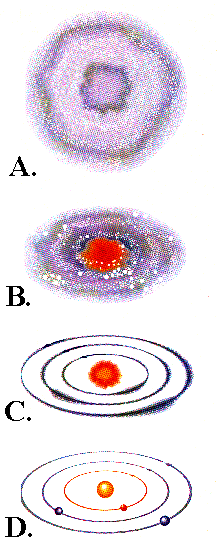
Solar System Inventory
· 1 Sun
· 9 Planets
· 40 Satellites
· minor planets/asteroids, interplanetary medium (gas, dust,
ice, etc.)
Distribution of Mass
|
Wt. %
|
|
Sun
|
99.86
|
|
Planets
|
0.135
|
|
Satellites
|
.00004
|
Some Properties of the Sun
Sphere of luminous gas
Surface temperature: @ 11,000 degrees F
Interior temperature: @ 20 x 10^6 degrees F
Composition of the Sun:
More than 65 elements have been detected in the Sun's optical spectrum,
including:
|
|
Volume %
|
| hydrogen |
81.76
|
| helium |
18.17
|
| all others |
00.07
|
mean density = 1.41 gm/cm3
Observations Bearing on the Origin of the Solar System
[Click Here for more views of the solar system]
-
All planets lie virtually in the same plane. Two exceptions include
Mercury, which is 7 degrees out and Pluto, which is 17 degrees out.
-
All planets revolve around the Sun in the same direction (counter clockwise).
-
With the exception of Venus and Uranus, all planets rotate in the same
direction.
-
When the asteroid belt is included, the orbits of the planets are regularly
spaced outward from the Sun, with each planet being located approximately
twice as far from the Sun as its innermost neighbor planet. This
is described by the Titus-Bode Rule.
-
The planets form two very distinctive groups based on size and density.
These include the small, inner terrestrial (earth-like) planets characterized
by densities between 4.0 and 5.5 gm/cc, and the outer giant (Jovian) planets
with densities between 0.7 and 1.7 gm/cc. This observation
implies that the inner planets have chemical compositions similar to that
of Earth, whereas compositions of the outer planets are more like that
of the Sun.
-
Radiometric ages of the oldest rocks on Earth, the Moon and meteorites
(including those identified as coming from Mars) have similar ages, and
suggest a common time of planetary formation at 4.7 billion years ago (4.7
Ga).
The Nebular Hypothesis
Current hypotheses link the origin of the planets to that of
the solar system itself. The modern theories actually date back to
ideas originally presented by the German philosopher Kant and the French
mathematician Laplace in the late 1700's!
 |
Modern theories are based on the observation that some areas
of interstellar space contain concentrations of gas (mostly H and
He) as well as dust of composition similar to terrestrial rocks.
These areas from what are known as nebulae. These slowly rotating
clouds of matter are dominated by forces of gravitational attraction and
the laws governing angular momemtum. Figure A illustrates
such a spherical cloud.
Under the influence of gravity, matter in the nubula will begin to be
concentrated in the center, and the nebula as a whole will contract.
This central area will become what is known as a proto-Sun.
As the nebula contracts due to gravity, conservation of angular momentum
requires that the rate of rotation must increase. As the rotation
increases, a flat, rapidly rotating disk forms around the proto-Sun, as
shown in Figure B. At this stage, this might look similar
to the current situation of the ring around Saturn. At the
same time, contraction of the material in the proto-Sun results in an increase
of both temperature (T) and pressure (P). At some stage of gravitational
contraction, T and P become high enough that nuclear fusion of Hydrogen
begins and the Sun starts to "burn".
Meanwhile, gravitational attraction of material in the rotating disk
(ring) will result in concentration of matter within regularly spaced "orbits"
within the disk (Figure C.
The gravitationally concentrated material within the now rapidly rotating
disk will coalesce to form the planets by a process known as accretion
(see below). By this time, the proto-Sun has achieved the T and
P necessary to sustain nuclear fusion.
[GIF image from Press and Siever (1994), Understanding Earth,
Freeman Publishing] |
N.B. Proof that modern-day disks of
matter around proto-stars can been seen in this telescopic
image
Formation of the Planets
All of the planets are believed to have formed by a process known as
accretion. This term means "to grow by being added upon".
It is a process whereby gravitational attraction pulls smaller particles
toward a larger (higher mass body). Accretion can best be understood
by realizing that it goes on to this day. The Earth's gravitational
attraction causes small bodies within the vicinity of the planet to gravitate
toward the Earth. We witness this phenomenon as meteors that today
are pulled to the Earth. Today the space around Earth is relatively
sparce, so meteorite impacts are relatively infrequent. However,
at 4.7 Ga, the space around Earth was very cluttered, and impacts
were both frequent and significant in size. This is the process of
accretion.

When the Earth (and other planets) was forming from the material in
the solar disk, the rate of meteorite impact must have been very high,
as depicted in Figure A. (above).
Meteorite impact is NOT a passive event, but one that releases large
amounts of energy. As an example, an iron meteorite with a volume
of 1 cubic meter has a mass of 10^6 grams (15,000 lbs). Such a body
impacting on Earth would have a velocity of 15 km/sec ((32,000 mph). Upon
impact, it would release kinetic energy (k.e. = 0.5mv^2) of 1.9 x 10^11
calories or the equivalent of 52 tons of TNT explosive! The net result
of numerous impacts is that the surface of the growing earth becomes very
HOT.

